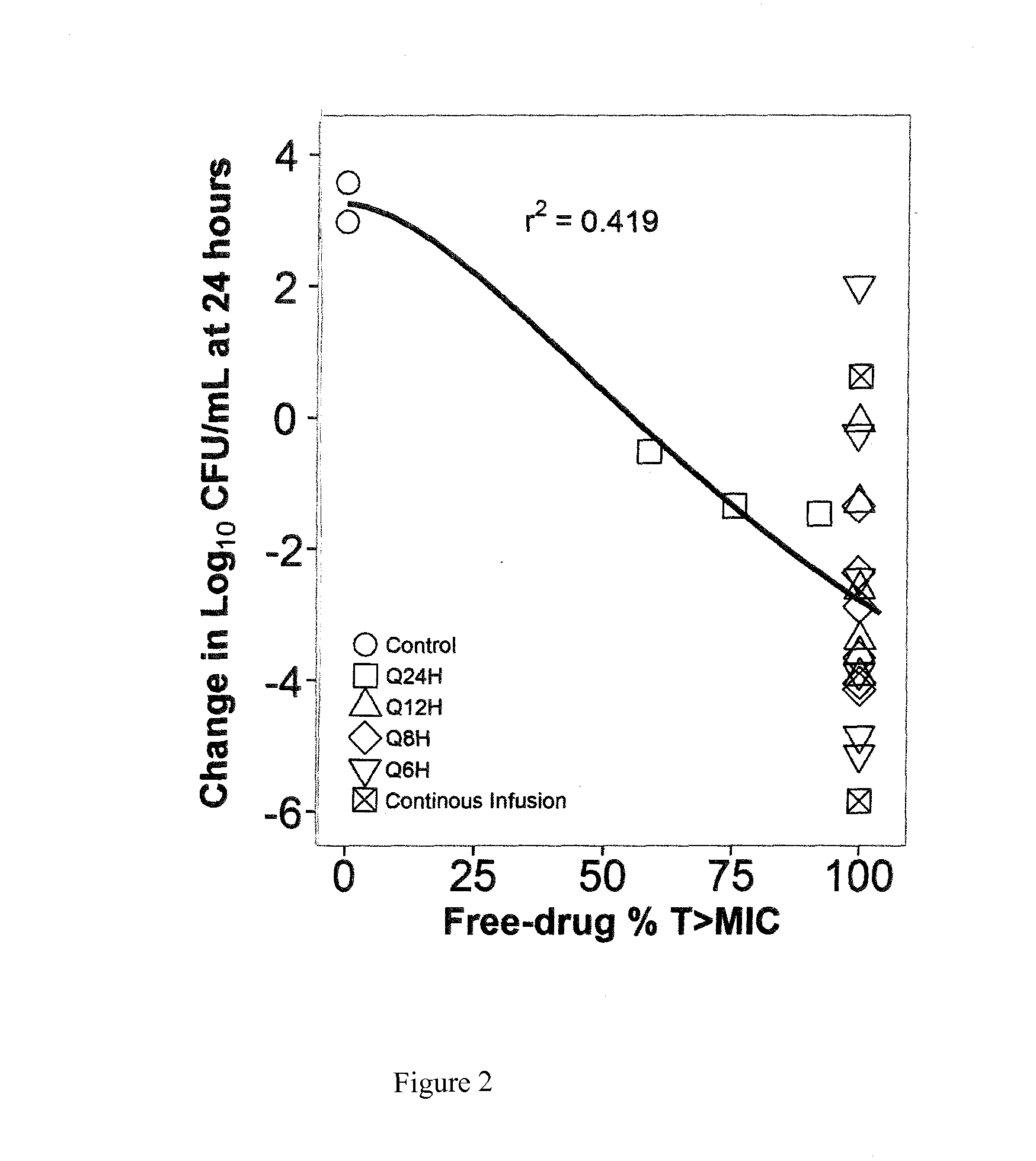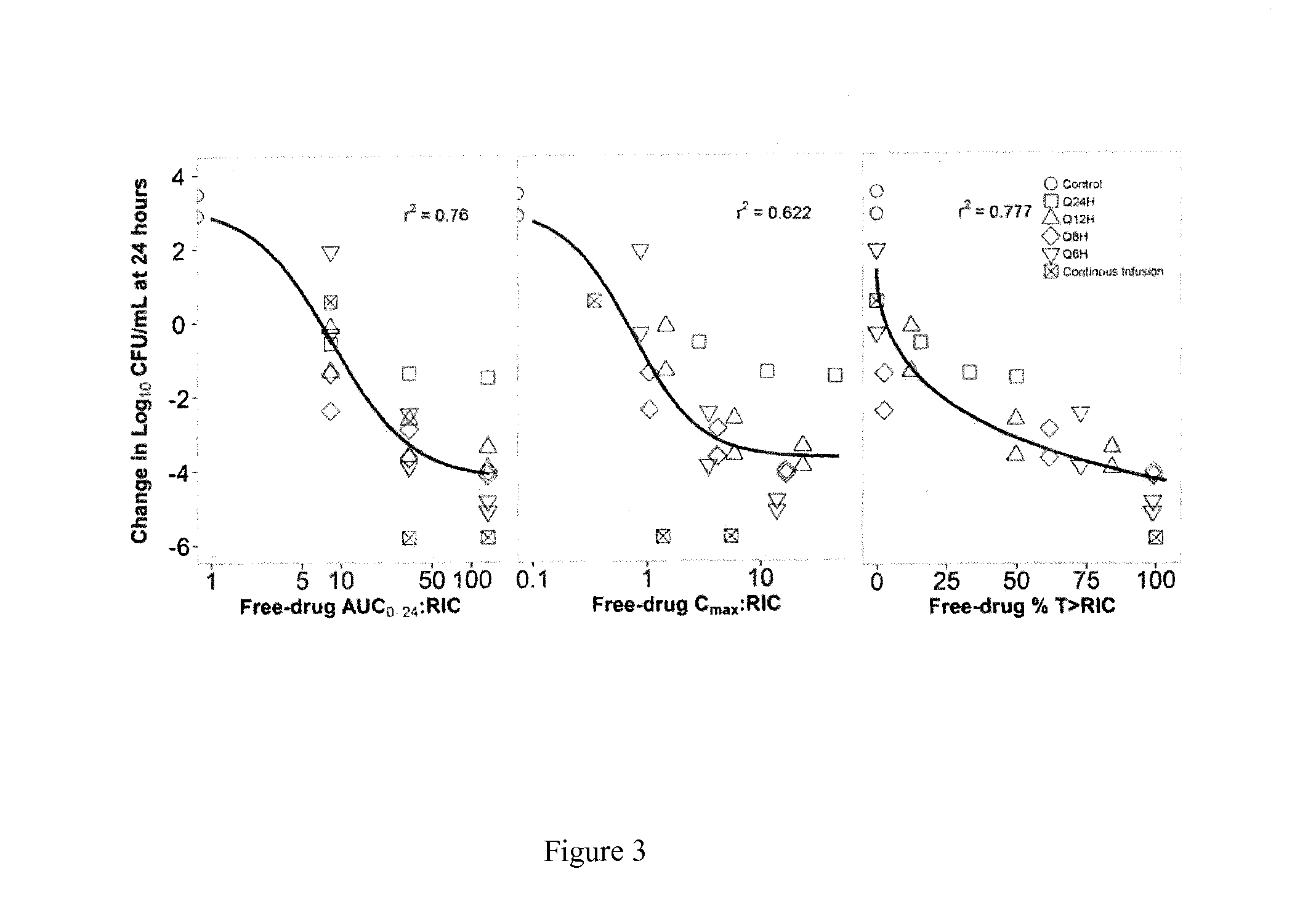Method for improving drug treatments in mammals
a drug treatment and mammals technology, applied in the field of mammals drug treatment improvement, can solve the problems of increasing treatment failure and mortality
- Summary
- Abstract
- Description
- Claims
- Application Information
AI Technical Summary
Benefits of technology
Problems solved by technology
Method used
Image
Examples
example 1
[0025]A dose-fractionation study was conducted utilizing a wild-type strain of Escherichia coli (ATCC 25922; fosfomycin MIC=0.5 mg / L agar; 1 mg / L broth microtiter) in a one-compartment in vitro infection model where the human drug concentration-time profile was simulated over a 24 hour study period. FIG. 2 shows the study results, where each regimen was identical in terms of total daily dose and % T>MIC (100%) but the change in bacterial density at 24 hours varied dramatically over an 8 log10 range. These results provide evidence that % T>MIC is not the PK-PD measure that best describes fosfomycin efficacy.
[0026]One reason for failure of % Time>MIC to describe fosfomycin efficacy is the presence of an inherently fosfomycin-resistant E. coli subpopulation (agar MIC 32-64 mg / L) within the standard starting inoculum of the susceptibility test method (5×105 CFU / mL). Another reason may be the volume of the micro-titer well (100-200 μL) used in the test method is small, containing 50,000-...
example 2
[0028]FIG. 3 shows the results of a dose-fractionation study that evaluated the PK-PD profile of fosfomycin against E. coli (ATCC 25922; fosfomycin resistant subpopulation agar MIC=32 mg / L) in a one-compartment in vitro infection model where the human drug concentration-time profile was simulated over a 24 hour study period. Note the relatively stronger relationship between the change in bacterial density and AUC0-24:RIC ratio and % T>RIC compared with that for Cmax:RIC ratio, where RIC is the concentration needed to inhibit the fosfomycin-resistant subpopulation.
[0029]There are two important implications of these findings, one relates to how fosfomycin should be dosed clinically and the other relates to diagnostic testing. First, based upon the strength of the relationship between the change in bacterial density and AUC0-24:RIC ratio and % T>MICR, it is tempting to conclude that either PK-PD measure could be used for dose optimization. However, further examination of these data rev...
example 3
[0031]In vivo animal studies utilizing the neutropenic murine-thigh model were conducted to confirm key results obtained from the in vitro PK-PD infection models. Initial goals of the studies were to confirm the presence of a clinically-relevant fosfomycin-resistant subpopulation in vivo and to confirm % T>RIC was the PK-PD measure that predicted response.
Methods
[0032]In brief, six-week-old specific-pathogen-free female CD1 (ICR / Swiss) mice were rendered neutropenic by two intra-peritoneal injections of cyclophosphamide, 150 mg / kg of body weight 4 days prior to the study and 100 mg / kg 1 day prior to the study. The challenge isolate was Escherichia coli ATCC 25922 (fosfomycin MIC, 1 mg / L), which was the same strain used in the aforementioned in vitro PK-PD infection model studies. Approximately 106 CFU / mL of the challenge isolate at mid-log-phase growth were injected into both thighs 2 hours before beginning therapy. The number of organisms in the thigh at the start of therapy in the...
PUM
| Property | Measurement | Unit |
|---|---|---|
| concentration | aaaaa | aaaaa |
| volume | aaaaa | aaaaa |
| time | aaaaa | aaaaa |
Abstract
Description
Claims
Application Information
 Login to View More
Login to View More - R&D
- Intellectual Property
- Life Sciences
- Materials
- Tech Scout
- Unparalleled Data Quality
- Higher Quality Content
- 60% Fewer Hallucinations
Browse by: Latest US Patents, China's latest patents, Technical Efficacy Thesaurus, Application Domain, Technology Topic, Popular Technical Reports.
© 2025 PatSnap. All rights reserved.Legal|Privacy policy|Modern Slavery Act Transparency Statement|Sitemap|About US| Contact US: help@patsnap.com



